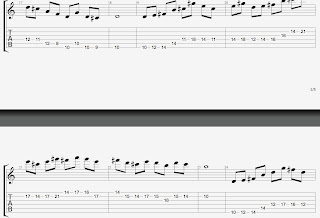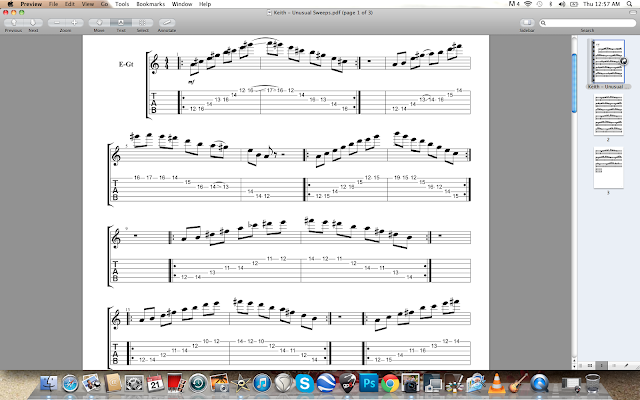Monday, March 4, 2013
Sunday, March 3, 2013
Thursday, February 21, 2013
Extended Arpeggios #1
Yo,
I have some more tabs for my latest YouTube upload!
Again we're dealing with some extended fretting patterns in the left hand, but the intention is to keep the right hand sweeping through these far-reaching intervals without having it sound too disjointed. These licks are dated from October 16th, 2012 and I decided to revisit them because I had only posted them as audio to my Facebook page.
The licks start off rather docile but they end up looking sadistic toward the end. The 6th to last lick (I believe) in D minor is a BEAST. I couldn't help but laugh when I saw the tabs and tried to figure out which way to warp my fingers. It's still playable though, and once the fingers adapt you'll be able to revert to the earlier stretches and see them in a new light. If you have a large enough reach it shouldn't be a problem; my hands are accustomed to this kind of thing by now, but I don't have Rachmaninoff sized hands. I'll share a bit of insight into each lick and then I'll showcase the tabs and the video link at the end.
1) A basic AM7 arpeggio, with the pinky doing the sliding on the high E string.
2) Another extended AM arpeggio shape - playing the 2nd on the A string is the real difficulty because everything seems very compressed shape-wise.
3) Am9 arpeggio. The stretch on the E string is played with a 1-2-4 fingering.
4) B mixolydian arpeggio in tight quarters again. There are a few like this, where you're moving up and backwards on the fretboard. It starts on A but it is seen as the b7.
5) Bm7 arpeggio. Pretty straight forward theoretically, but it moves like the previous lick and is uncommonly played in this shape.
6) I like to see this one as a form of highlighting the melodic minor scale in a sweep. It is in Am (most of the shapes start on A). The cool intervals come around when you stretch from the F# (6th) to the 2nd/9th (B), a fourth, then followed by a minor second interval from the 2nd to the minor 3rd (C).
7) Another simple one in theory: whole-tone. The biggest pain in the ass is choosing which fingers to use in this lick. The pain with whole tones (and tri-tones) is the incongruity of the shapes on the guitar neck; they tend to be very angular.
8) This is based on the 4th mode of the melodic minor scale (Mixolydian #4). Notice the tri-tone b5 interval between the G and B strings.
9) 2nd mode of the melodic minor scale, Dorian b2, turned into a sweeping lick. The first three notes are played with 1, 3, and 2 fingerings respectively, it will free up the index to move to the next string.
10) 5th mode of the melodic minor scale (the Hindu I believe it is called). A good change of direction occurs and an interval of a 5th is thrown in. All extremities are played with index and pinky, the inner fretting is about comfort.
11) This revolves around the Phrygian Dominant scale, or the 5th mode of the Harmonic Minor modes. A fairly easy one compared to most.
12) Very stretchy territory. Play the 12 to the 17 with the index and 3rd finger! You'll also want to barre the D and F# notes (19th fret) with the 3rd finger.
13) The beast lick in D minor. The best way to explain the fingering is to avoid the use of the pinky until the last note. All other triads are played with 1-2-3.
I think by this point you get the idea. It is well after 3 AM and the explanations are getting so bad. Stretch, stretch, stretch. Practice, practice, practice. The last two licks are all octave based - very straight-forward. They're purely stamina and precision based.
Thursday, February 7, 2013
Legato-Economy Two-Three
I'm feeling a little bewildered. How has this page been getting so many views when I haven't done shit in so long!? After sharing all of the Slonimsky tabs I felt like the page wasn't really getting the love it deserved, particularly the lack of feedback on the actual page itself. The majority of requests I get concerning the blog are coming from players that I've met through YouTube, or from friends on Facebook who are seeking tabs. I've come to realize that posting a video of me playing a million notes on a Macbook iSight camera is not the best way for people to learn from me. The problem has always been the amount of time it took me to upload to the blog vs. the effect it seemed to lack. Coming back to the blog has been educational, and it seems like it's worth the second effort. Perhaps I will post more frequently, although the material will have to be lighter. If I try to continuously match the content I provided with the Slonimsky transcriptions...
Just to give you an idea of how I get tabs on here, and why it can sometimes piss me off:
- I noodle around until I find an idea worth exploring
- I spend the requisite amount of time perfecting the technique and building examples
- I record them visually
- Normally I don't write the tabs out when I play, so I'll watch the video and tab them out by ear
- I write the licks into a tab software program
- I have to screenshot them individually so they are legible/not cut off by pages
It's a lot of work. There's also the option of adding fingerings, pickstrokes, etc. etc.
Anyways, we'll move on to the reason why I came back to the blog. These licks are awesome!
Before continuing there are a few guidelines. Always stretch before you play these kinds of licks. I've already dealt with repetitive stress injuries (my fretting pinky) and it's the perfect way to ruin your craft. As you'll see, the licks become increasingly wider and more demanding for the fretting hand. That's a good thing, and the fretting hand is the focus of these exercises, but start slow. Secondly, there are no fingerings. The reason why: I'm lazy, fingerings are an individual choice, and I also believe that the licks are predisposed to a certain technique. If possible try to incorporate all 4 fingers. I had to screenshot the tabs so there are no 'Ex' numbers, but they will follow the format of the YouTube video of me playing them.
Meet example 1. The purpose of these exercises is simple: continuous motion, and the ability to ascend and descend without meeting any obstacles/resistance. This is precisely why the ascending and descending patterns are different. Ascending from E to E strings, we are employing strict legato. We are dealing with the trusty old 3 octave technique. If you visualize it that way, you will see 5 notes per octave ascending, with a distribution of 2 and then 3 (regarding notes played per string). I like to pick the first note on a downstroke, hammer to the next. When going to the next string (the string with 3 notes) I'll use an upstroke and hammer both adjacent notes. Rinse and repeat.
When you reach the high E string you will be doing a longer legato sequence. This sequence is what I would consider the pivoting action of the lick. It allows you to get ready for the double upstroke attack that follows for the descending sequence. In this example the second time you play the G# (fret 16 E string with the downstroke indication) is when you are focusing on the descending portion. It starts with a downstroke (on G# 16th fret) and pull off to the E note on the 12th fret. After the pull off you will want to play the next two notes (as shown) with a double upstroke. This is treated almost like a short sweep and followed by a pull-off (in this case we double downstroke through F#, C# and we pull-off to the B note). *A great place to see this technique is Jason Becker's AIM Clinic videos; he used it extensively for pentatonic ideas. The process is repeated twice more and you are back to square one on the low E string. Play the first note only once if you wish to play through the lick a second time without stopping.
Thanks for stopping by!
youtube.com/keithwhalen11
Subscribe to:
Posts (Atom)
























































